Initial Setup
Custom Fields
Support Guide
-
Overview
Custom Fields in Striven allow users to collect and track specific information with fields that are not available by default with your Striven system. These fields can be added on both a global-level and a type-level to meet your data capturing needs. Type-level Custom Fields are only visible for entities created of those specific types (e.g., Sales Order Types, Task Types). Global-level Custom Fields are visible for the created entity, regardless of type. They can be created, viewed, and managed in the settings area. The following sections will guide you through managing global-level and type-level Custom Fields.
Read this guide if you are trying to:
✔ Create or manage Custom Fields throughout Striven.
✔ Understand different Custom Field areas and their applications.
✔ Making Custom Fields required, encrypted, or visible on the Portal.
-
Global Custom Fields
Custom Fields added at the global level will appear on all the entities created on the related level. For instance, if you add a global Custom Field for Sales Orders, then ALL Sales Orders will feature the Custom Field.
Global Custom Fields can be added and managed in the Custom Fields settings by navigating to Company → Settings → Company → Customizations → Fields.

Example of the Global Custom Fields Settings Page

-
Entity Level-Specific Custom Fields
In addition to global Custom Fields that are present on all entities created on the associated level, Striven also has type-specific Custom Fields that are only displayed on entities of that specific Type. For example, if a Custom Field is added for a particular Sales Order Type, it will only be present on Sales Orders of that Type.
Type-specific Custom Fields are available for the following entities:


Custom Fields on a type-level are located by clicking on the waffle menu in the top left corner of the Type – Info page, next to the Type Name.

Example of the Waffle Menu Showing the Custom Fields Option for a Task Type

The process of creating type-level Custom Fields is the same as for global Custom Fields. However, type-level Custom Fields are only visible on the Type for which they were created.
-
Adding Custom Field Sections
Custom Field Sections provide a methodical way to group and categorize your Custom Fields, ensuring that data collection is aligned with the specific context of the information being gathered. By creating designated sections, you can effectively compartmentalize your Custom Fields, making data entry more intuitive and efficient.
Whether you’re working with global Custom Fields or type-level Custom Fields, you will follow the same steps when adding Custom Field Sections.
You can create a new section by scrolling to the bottom of the Custom Fields Settings page and clicking on the Add Section option there to trigger the Add Section popup.

Example of the Add Section Option at the Bottom of the Custom Fields Settings Page

Alternatively, you can add or edit sections by clicking on the Manage Sections button. This displays the Manage Sections popup with options to add sections, edit existing sections, or deactivate sections.

Example of the Manage Sections Popup for Custom Fields

- Note: The Custom Fields Settings pages provide you with a default Additional Info section already added to your system. This section does not have any default Custom Fields, so you won’t see the section displayed in the system unless or until Custom Fields are added to it.
To add a new Custom Field Section, click on the blue Plus (+) icon. This displays the Add Section settings wherein you will enter a Name for the section, as well as a section Description if you so choose.

Example of the Add Section Popup with the Description Field

The Description field can be used to identify the information you’re trying to gather within the related Custom Fields, instructions for filling out the Custom Fields, or any other descriptive information you wish to display there.

Example of How the Custom Field Settings Display on a Task

The Section Description will display above the Custom Fields in the Custom Field section. This Description field is for internal purposes only and will only display for users within your Striven system, not in read-only modes or in the Customer/Vendor/Career Portals.
After you have entered the Name and Description, click on Save & Close to create the Custom Field Section. This returns to the Manage Sections popup with a list of the Custom Field Sections. When you’re finished adding or editing sections, click Close to return to the Custom Fields Settings page.
-
Adding Custom Fields
The process of creating Custom Fields is consistent for both global-level and type-level fields. The primary distinction lies in where they are created within the system. Global Custom Fields are managed within Company Settings, whereas type-level Custom Fields are managed from the Type Settings page of the specific entity, such as a Sales Order Type.
To create a new Custom Field, click the Plus (+) icon. This will open a popup where you can select the desired field Type. Choosing the appropriate field Type is crucial for accurate data capture. For instance, if you are dealing with budgetary information, a currency field would be the most suitable choice.
After a field Type is chosen, you can then decide if you would like to make the field Required and in some cases Encrypted as well. Making a field Required means that users must input data into that field before they can save their progress and move on. This is useful for critical information that should not be omitted. Setting the field as Encrypted adds a layer of security to protect sensitive data. Access to view or edit the encrypted data is managed by maintaining a list of authorized users, which can be set when turning on the encryption option.
- Name: Allows you to name the field being added.
- Description: Allows you to enter a description of the data captured in this Custom Field for better understanding of the field’s purpose.
- Type: Allows you to choose what type of data you would like to be input and captured for the Custom Fields being added. Choices include date, currency, alphanumeric, and many more. The different Custom Field types will be described below.
- Section: The name of the section in which the Custom Fields will be added to. When filling out Custom Fields, sections will allow for the fields to be organized and sectioned off.
- Field Options: Displays options available for the data type that has been chosen. Options that can appear are listed and described further below:
- Is required: When toggled on, this will make the field required on pages for which it appears.
- Is encrypted: When toggled on, this will make the field encrypted on pages for which it appears. If this option is selected, then another field will appear in which you can choose who can access data entered in these fields. If no Employee is selected, then all Employees can access the data.
- Save Options: There are three (3) button options:
- Save: Saves the current state of the Custom Field letting you continue working without the risk of losing your progress.
- Save & Add New: Saves the Custom Field and provides a new Add Custom Field page to create another Custom Field.
- Save & Close: Saves the Custom Field and closes page, returning you to the Custom Fields List page.
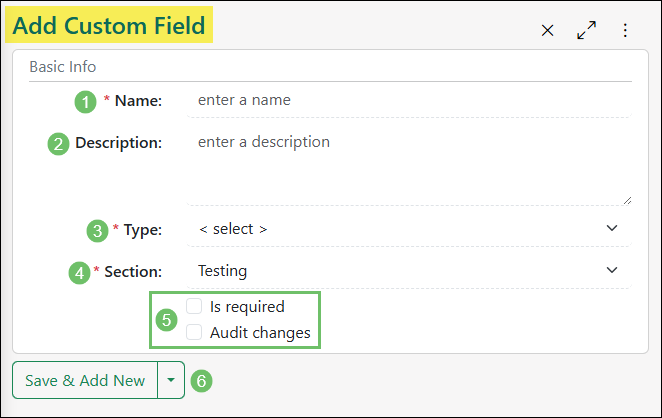
Example of Adding a Custom Field

-
Custom Field Types
Custom Fields have a variety of options for capturing different types of data in different formats. Below is a list of the Types of Custom Fields that are available in Striven along with a brief explanation of how they can be used.
- Alphanumeric Field: Allows you to capture both alphabetical and numeric data entered in a line of text.
- Integer Field: Allows you to enter numeric data as whole numbers (no decimal points). The system will automatically add commas within the numbers to display the proper number format.
- Decimal Field: Allows you to enter numeric data, including decimal points.
- Currency: Allows you to enter numeric data, which will then be put into currency form with a $ symbol in front of the entered value.
- Date and Time Field: Allows you to click the Calendar icon to choose a date and the Clock icon to choose a time of day.
- Date Field: Allows you to click the Calendar icon to choose a date.
- Time Field: Allows you to click the Clock icon to choose a time of day.
- Yes/No Field: Provides the option to choose Yes or No to select the appropriate value.
- Alphanumeric Multiline Field: Allows you to capture both alphabetical and numeric data and enter multiple lines of text as needed.
- Attachment: Allows you to upload documents into the Custom Field. Hovering over the Info icon will display the allowable file extensions for this field, and the Max File Size is 100MB.
- Select Value from Custom List Items: Allows you to create a Custom List to store in Striven. Once added you will be able to choose the correct option from the list to enter data in the field. Learn how to set up Custom Lists in the section below.
- Select Value from Existing List: Allows you to choose from an existing list in Striven including Employees, Customers, etc. Once the list is selected, you will be able to choose the correct option from the list to enter data in the field.

Example of the Available Custom Field Types

Certain Custom Field Types will display another setting option for Display Type, offering the choice to select how the Custom Field displays. These Display Types are discussed in further detail below.
Custom Field Display Types
The Yes/No Field provides the following display options:
- Radio Button: Provides a clickable button next to each response option so the user can clearly indicate their answer by selecting one or the other.
- Checkbox: Checking the box provides a “Yes” response, while leaving the box unchecked provides a “No” response to the question posed in the Custom Field.
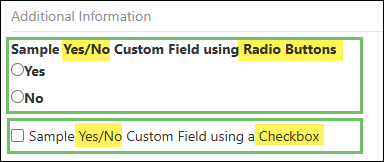
Example of the Display Types Available for Yes/No Custom Fields

The Alphanumeric Multiline Field provides the following display options:
- Rich Editor: Provides a Rich Editor box to enter your response to the Custom Field. This field includes formatting options for font style, type, size and color, as well as bulleted and numbered list options, an insert table option, hyperlink manager, and the ability to insert an external video.
- Multi-line Textbox: Provides an extended space to enter multiple lines of text as a response to the Custom Field. This field does not provide any formatting options or features for adding additional content other than text.

Example of the Display Types Available for Alphanumeric Multiline Custom Fields

The Select Value from Custom List Items Field provides the following display options:
- Drop-down List: Displays the Custom List items in a drop-down list format to easily select the desired list item while maintaining a clean, simple appearance and saving space on the page.

Example of the Drop-down List Display Type for the Select Value from Custom List Items Custom Field

- Load On Demand: Displays a type-ahead field wherein you can start typing the list item name and the system will load a list of matching results as you type.
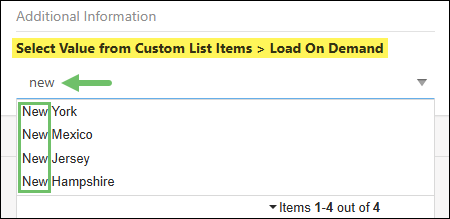
Example of the Load On Demand Display Type for the Select Value from Custom List Items Custom Field

- Drop-down with Checkboxes: Displays the Custom List items in a drop-down list format with checkboxes to allow for multiple selections as a response to the Custom Field.

Example of the Drop-down with Checkboxes Display Type for the Select Value from Custom List Items Custom Field

- Radio Button List: Shows the Custom List items with radio buttons to allow for the selection of a single option.

Example of the Radio Button List Display Type for the Select Value from Custom List Items Custom Field

- Checkbox List: Shows the Custom List items with checkboxes to allow for the selection of multiple options.

Example of the Checkbox List Display Type for the Select Value from Custom List Items Custom Field

- Drop-down List with Other: Displays the Custom List items in a drop-down list format, including an additional option of “Other” which when selected will display a text field to enter a response.
- Note: You do not need to add “Other” as a list item to your Custom List to use this display option as it will automatically add it along with the text field when “Other” is selected.

Example of the Drop-down List with Other Display Type for the Select Value from Custom List Items Custom Field

- Radio Button List with Other: Shows the Custom List items with radio buttons to allow for the selection of a single option, including an additional option of “Other” which when selected will display a text field to enter a response.
- Note: You do not need to add “Other” as a list item to your Custom List to use this display option as it will automatically add it along with the text field when “Other” is selected.

Example of the Radio Button List with Other Display Type for the Select Value from Custom List Items Custom Field

- Checkbox List with Other: Shows the Custom List items with checkboxes to allow for the selection of multiple options, including an additional option of “Other” which when selected will display a text field to enter a response.
- Note: You do not need to add “Other” as a list item to your Custom List to use this display option as it will automatically add it along with the text field when “Other” is selected.
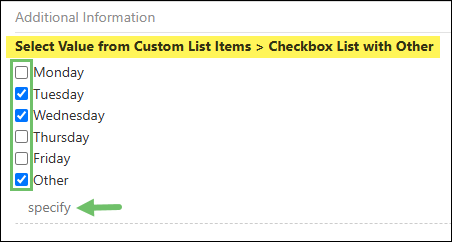
Example of the Checkbox List with Other Display Type for the Select Value from Custom List Items Custom Field

-
Managing Custom Fields
To manage Custom Fields in Striven, you have several options for creation, organization, and control depending on whether you are working with global Custom Fields or type-specific Custom Fields.
Global Custom Field Management
The Custom Fields Settings page contains a drop-down list of entities for adding or managing Custom Fields. Custom Fields can be added in many areas throughout Striven, including Candidates, Company Assets, Customers/Vendors, Departments, and Employees. Any Custom Field that is created at the global level will appear on the associated entity regardless of the Type selected.

Example of Global Custom Fields Settings for Employees

- Page Actions: There are two (2) options located in the top-right corner of the page:
- Expand/Collapse: Extends or reduces the screen view to optimize and adjust to viewing the page on various device screen sizes.
- Settings Menu: Offers three (3) options:
- Settings: Displays your page access settings and provides a button to request access to permissions needed for access to the info on the page.
- Make Landing Page: Updates the current page to be your Landing Page when you sign in to Striven.
- Helpful Links: Links to useful resources outside of Striven to provide further information related to details on the current page.
- Choose Entity: Allows you to choose from the drop-down list which area of the system for which you would like to add or manage Custom Fields.
- Manage Sections: Enables you to manage Custom Field sections. This is also where you will look to Add new Custom Field sections. This feature will enable you to save different sections per system entity.
- Include Inactive Sections/Fields: Displays any sections or fields that have been previously marked as inactive. Once viewing inactive sections/fields you will have the ability to mark them active again.
- Section Name: Indicates the nature of the information related to the Custom Fields within the section.
- Add Custom Field: Allows you to add a new Custom Field to the section. This will initiate a popup of choices, which are discussed further in this guide below.
- Name Column: Displays the name of all active Custom Fields in the section. The name is hyperlinked to allow for easy editing of the Custom Field settings.
- Type Column: Displays what type of data is being captured in the related Custom Field. The different Custom Field Types will be described below.
- Rearrange Tool: Allows you to rearrange the Custom Fields in the section by clicking the dotted icon to drag/drop the Custom Field to the desired placement in the section.
- Deactivate: Makes the Custom Field inactive and removes it from displaying in the Custom Field section of the related entity.
Type-Level Custom Field Management
Custom Fields at the type level are managed from the waffle menu of the Type Settings page. Depending on the Type of entity you’re adding the Custom Field for, there may be additional Custom Field options for specific uses. For example, Contract-Managed Sales Orders can have type-level Custom Fields that are set to be displayed on the Sales Order Approval page, or a Task Type can be set to display certain Custom Fields when marking a Task Done.

Example of Custom Fields Settings on a Sales Order Type Waffle Menu

The Custom Field Settings pages function almost identically at both type and global levels. The only variations are the location from which you access the pages and the inclusion of the entity selection field. Remember, this field, found only at the global level, allows users to designate the specific entity to which the Custom Field settings will apply.
- Page Actions: There are two (2) options located in the top-right corner of the page:
-
Custom Lists
As previously mentioned in this guide, one Custom Field Type you can utilize is Custom Lists. Once a Custom List is created, it will be added to the global page of Custom Lists. There you can view, create, and manage Custom Lists as needed. By clicking the Add button, you will be able to add a new Custom List, which will then be available for new Custom Fields that use the field type Select value from Custom List Items.
To add or manage Custom Lists, navigate to Company → Settings → Company → Customizations → Lists.

Example of Custom Lists Page

- Add: Opens the Add Custom List page with fields for List Name and List Items.
- Page Actions: There are three (3) options located in the top-right corner of the page:
- Search: Opens a Search popup with filters for Name and Status to help narrow down the results and locate the exact Custom List for which you are searching.
- Expand/Collapse: Extends or reduces the screen view to optimize and adjust to viewing the page on various device screen sizes.
- Settings Menu: Offers three (3) options:
- Settings: Displays your page access settings and provides a button to request access to permissions needed for access to the info on the page.
- Make Landing Page: Updates the current page to be your Landing Page when you sign in to Striven.
- Helpful Links: Links to useful resources outside of Striven to provide further information related to details on the current page.
- Filters: Displays the current filters used to show the results on the page. You can also click on the Filter icon to edit the filters.
- Sort: Switches the sorting order of the search results between ascending and descending alphabetical order.
- List Name: Identifies the Custom List and provides a link to edit the related settings.
- Deactivate: Marks the Custom List as inactive so it cannot be selected for use with any Custom Fields. Inactive Lists can be reactivated by filtering the search options to display inactive lists and then clicking on the green Activate icon next to the Custom List you wish to reactivate.
-
Adding a Custom List
The steps for creating a Custom List are simple and straightforward. Below is an example of the Add Custom List page with descriptions of the available options.
- List Name: Identifies the Custom List in your system for easy access and organization.
- List Items: Allows you to enter the items you want to appear on a Custom List. You can then select from this list when using the List in a Custom Field.
- Rearrange Tool: Allows you to manually sort the List items by clicking/dragging the dotted icon to the desired position.
- Item Name: Shows how the List item name will be displayed in the List. You can click in this field to edit the name.
- Delete: Removes the List item from the list.
- Sort Alphabetically: Automatically sorts the List items alphabetically.
- Save Options: There are three (3) button options:
- Save: Saves the current state of the Custom List letting you continue working without the risk of losing your progress.
- Save & Add New: Saves the Custom List and provides a new Add Custom List page to create another Custom List.
- Save & Close: Saves the Custom List and closes page, returning you to the Custom Lists page.
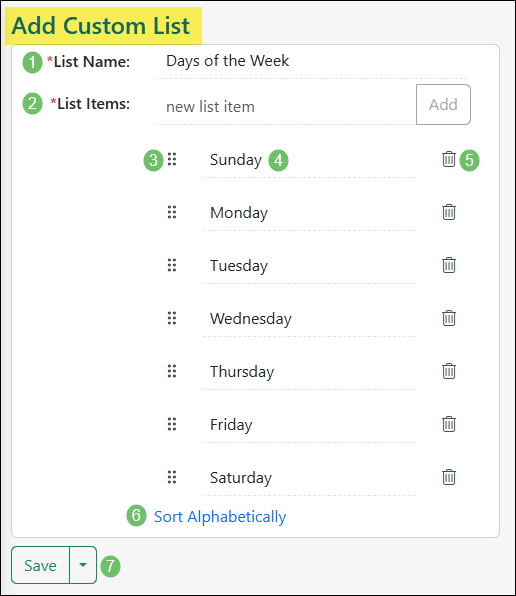
Example of Adding a New Custom List

Once you have saved your new Custom List, it should display as a selectable option when using the Select Value from Custom List Items Custom Field Type.
-
Deactivating Custom Fields
When deactivating Custom Fields in Striven, the system checks to make sure that the Custom Field is not being used as either a filter or column in any active custom reports. If it is, there is an error notification that displays noting how many reports are using that Custom Field which is hyperlinked to load the Reports page, automatically filtered to show only the reports to which the user has access and are using that Custom Field. This will make it easier to remove the Custom Fields from the reports or to deactivate the reports.

Example of the Error Notification When Deactivating a Custom Field

- Note: Users will only see reports that they have access to on this page, so if there are other reports using the Custom Field, the user will have to contact their system administrator or someone with the appropriate report access to continue the process of deactivating the reports or the Custom Field.

Example of the Reports Page Filtered for Active Reports Using a Particular Custom Field

-
Completing Custom Fields
After your Custom Fields have been created, users can enter the relevant information in them when they display in the area of the system for which they were created. Below is an example of how Custom Fields can appear based on their display settings.
- Global Custom Fields: Global Custom Fields appear above the level-specific Custom Fields.
- Required Custom Fields: Custom Fields that are marked required will have an asterisk icon appear at the end of the Custom Field name. These fields must be completed before the entity (Order, Project, etc.) is created or saved. In the case of Tasks, required Custom Fields will need to be entered before the Task can be marked Done.
- Encrypted Custom Fields: Once data is entered into encrypted Custom Fields, the data will be protected by a line of asterisks along with the following two (2) options:
- Edit: Allows users with the proper access (set at the Custom Field configuration) to edit the data entered into the Custom Field. Once selected, the data returns to a readable text for ease with editing until it is saved.
- Copy: Allows users with proper access (set at the Custom Field configuration) to copy the data to their clipboard to easily paste the information in another field, document, or anywhere else the pasting function is supported.
- Level-Specific Custom Fields: Below the global Custom Fields is where level-specific Custom Fields will be located and have the same functionality as global level Custom Fields.
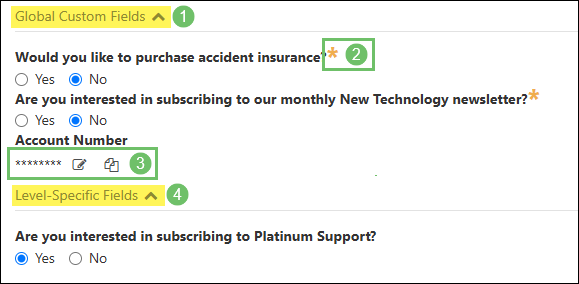
Example of How Global-Level and Type-Level Custom Fields May Appear on a Sales Order

-
Recap
With this Custom Fields Guide, we’ve covered managing global Custom Fields, adding new fields with various data types (e.g., alphanumeric, date, currency), and configuring field options. We have also explained Custom Field Sections, Types, and Display Types, as well as how to create and manage Custom Lists for use within Custom Fields. Additionally, we’ve discussed Entity Level-Specific Custom Fields for specific entity types and provided information on completing Custom Fields.
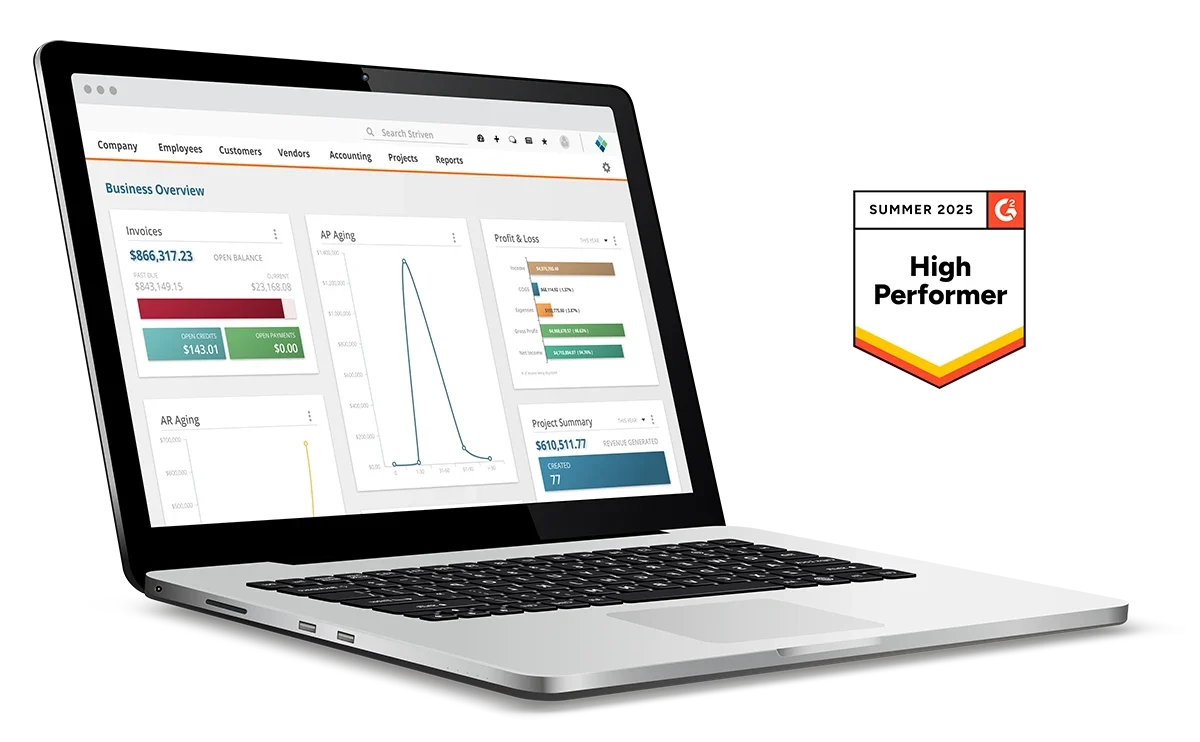
Have a Question?
Ask the Striven Community
User-sourced how-to’s, feedback, and more!
FAQs
-
I’d like to change the data captured in my Custom Field. How can I accomplish this?
Once a field is created the data type cannot be changed. To accomplish changing the data type, it is recommended that another field be added and the data from previous fields be copied over as to not lose any previously entered data.
-
I’ve created a Custom Field, but I would like to encrypt any data captured for it in the future. How can I accomplish this?
Encryption is something that must be configured when creating a new Custom Field. It is recommended that a new Custom Field be created and the older field be deactivated since encryption has its own security parameters as well.
-
I’ve created a Custom Field, but I would like to require users to complete the Custom Field. How can I accomplish this?
Marking a Custom Field required can occur at any time and can be done from the Custom Field either at the level-specific level or global level in the settings.
